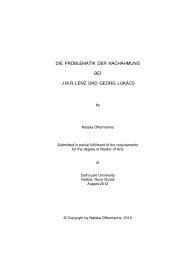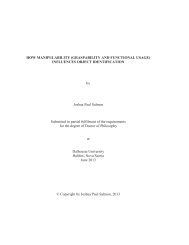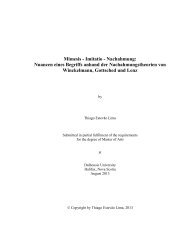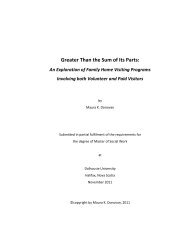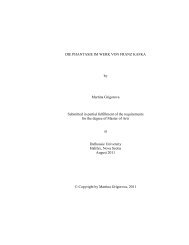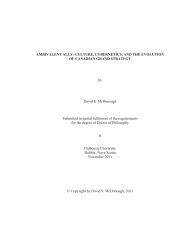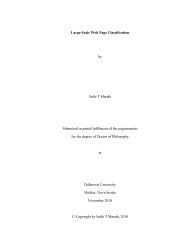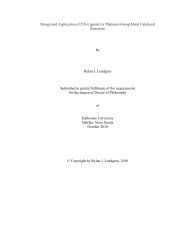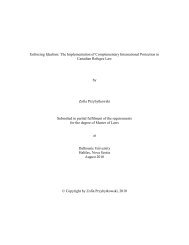ADAPTING TRISTRAM SHANDY by Adria Young Submitted in ...
ADAPTING TRISTRAM SHANDY by Adria Young Submitted in ...
ADAPTING TRISTRAM SHANDY by Adria Young Submitted in ...
You also want an ePaper? Increase the reach of your titles
YUMPU automatically turns print PDFs into web optimized ePapers that Google loves.
notion of a literal fidelity” (7) to the text; that is, it is vague enough to dodge the blows of<br />
fidelity criticism, and can validate even the freest of adaptations. In addition, spirit<br />
“demonstrates a much greater sophistication <strong>in</strong> the general culture” (MacCabe 7),<br />
whatever that means. In recognition of this lack of general def<strong>in</strong>ition that “spirit” holds<br />
(or does not hold), each usage <strong>in</strong> adaptation criticism has to be particularized to the<br />
specific, orig<strong>in</strong>al source of the adaptation, which can take on various mean<strong>in</strong>gs,<br />
depend<strong>in</strong>g on the theorist. Spirit can account for the “themes” that have been adapted<br />
(Hutcheon 20), for <strong>in</strong>stance. But this ‘spiritual’ approach only works for films that<br />
conceptually adapt the orig<strong>in</strong>al text.<br />
In recognition of the fairly conceptual and abstract applications of “spirit,” it<br />
becomes clear that there are gradations of adaptations. There is the first level of<br />
adaptation that attempts the direct text-to-screen transfer. Then, there is the modernized<br />
or reworked adaptation. And, f<strong>in</strong>ally, there is the k<strong>in</strong>d of adaptation that is true to the<br />
spirit of the text. If spirit is abstract, on the third level, then fidelity, at the ground floor, is<br />
literal. The fidelity approach as a critical tool is thus relegated to the first level of<br />
adaptations that attempt direct text-to-screen transfers. The “heritage film” (Mayer 1), for<br />
<strong>in</strong>stance, is a genre with<strong>in</strong> which the primary aim is to recreate the text and its contexts,<br />
historical or social, to the word, like the BBC Films versions of the novels of Jane<br />
Austen, for example. Other recent and notable “faithful” literary adaptations <strong>in</strong>clude<br />
Khaled Hosse<strong>in</strong>i’s The Kite Runner (Forster 2007), Cormac MacCarthy’s The Road<br />
(Hillcoat 2009), and the ten film and television versions of Charlotte Brontë’s Jane Eyre,<br />
with the most recent version <strong>by</strong> Cary Fukunaga (2011). Really, this list of direct<br />
adaptation films is endless; there is significant <strong>in</strong>terest <strong>in</strong> adaptations that attempt the<br />
3



